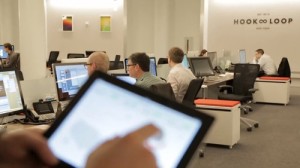Infor CEO Charles Phillips has made plenty of changes at the ERP (enterprise resource planning) software vendor since taking the top job after a long run as co-president of Oracle, and one of the most significant is a major investment in modern user interface design.
Phillips created an internal design agency called Hook & Loop, which works closely with Infor application development teams. Now he’s gone a step further, naming Hook & Loop’s director Marc Scibelli to the new post of chief creative officer.
Some 80 people now work at Hook & Loop, up from 15 at the beginning of this year. The unit’s name is a nod to the generic term for the easy-to-use fastening technology popularized by Velcro.
“We wanted to empower Marc to do more inside the company,” Phillips said in a recent interview. “Software development is a very structured process and the engineers are used to working that way, on very defined schedules.”
In contrast, creative types like to seize upon the freshest ideas and are more willing to change course if they believe it will make a project better, according to Phillips. “I need a team that’s obsessed with the new things by the day,” he said. “We don’t want to wait until something’s mainstream. We at the size where we can do that and get it into our products quickly.”
Scibelli will report to Infor president Duncan Angove, who oversees engineering, support and cloud computing.
Scibelli and his team have already earned the trust and cooperation of Infor developers, Philips said. “Now when they call, people are eager to hear what they have to say.” His new role will give Scibelli more “impact and authority,” Phillips said.
Infor’s new interface, dubbed SoHo, was launched earlier this year. Phillips believes that Infor can shove aside the competition if it can only get prospective customers, particularly end users, to take a look.
“Historically, people who buy [ERP products] didn’t have to use it,” he said. “As much as possible, we want to get a demo in front of everybody. If any users see our product we have a much higher chance of winning. That’s just the opposite of all our competitors. They try to get out of doing a demo.”
There’s a catch, though, namely that Infor isn’t giving its entire back catalog the SoHo treatment. Customers must be on version 10 of Infor’s core ERP platform, meaning many members of the installed base will have to upgrade before they can take advantage.
Next month, Infor will launch an upgrade program targeted at these customers that includes standard pricing, data migration tools and other features. It’s also geared toward cloud, versus on-premises deployments. “We want to move them directly to the cloud and in the process of that upgrade, get them to that latest release,” he said.
Overall, Phillips’ investment in user interface design has been a good move, according to analyst Ray Wang, CEO of Constellation Research. “There’s a battle for user experience,” Wang said. “It’s key to driving new license sales and adoption.”
Infor’s back catalog is “as green as the greenest green screens,” Wang said. In contrast, “Infor’s new stuff is very good. It’s mobile-first designed. We’ve had a few dozen customers choose Infor for UI over SAP and Oracle.”
Infor’s competitors aren’t standing still when it comes to user experience, however. SAP is working on a range of projects, such as the LAVA “design language” for its BI (business intelligence) suite and App Haus, a special development unit working on next-generation user interfaces. Oracle has worked extensively on user testing for its Fusion Applications, which incorporate embedded BI and other modern touches.
In some ways, ERP vendors are being forced to reinvent their products’ look and feel. One driver is the rapid rise of smartphones and tablets, which require software to be reconfigured to account for smaller screen sizes. Observers also often point to the younger members of today’s workforce, who grew up on user-friendly consumer software and expect their business applications to provide a similar experience.





